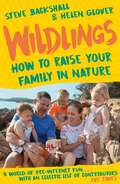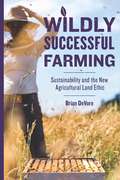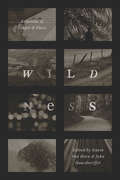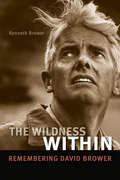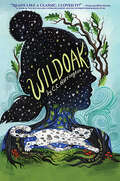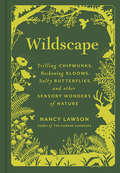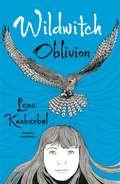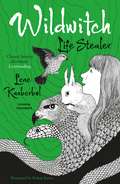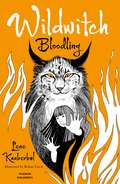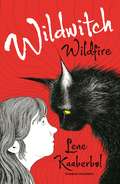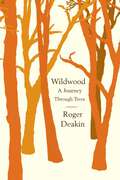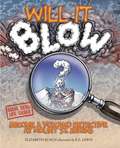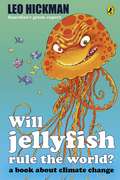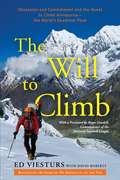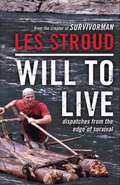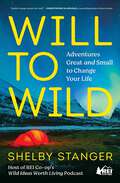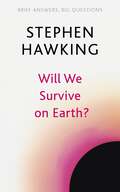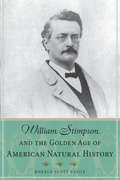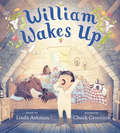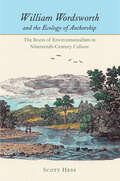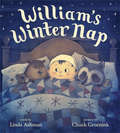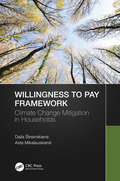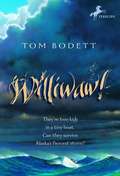- Table View
- List View
Wildlings: How to raise your family in nature
by Steve Backshall Helen GloverThe ultimate handbook for raising wilder, happier, muddier, more resilient kids - whatever the weather and wherever you live.In the last few years parents everywhere have realised how crucial the freedom of the outside world is, not only for their kids' wellbeing, but the whole family's. They've also realised, however, that it's not always that easy. That's where this book comes in. Taking you through different environments and activities to explore, from minibeasts in the garden and pond dipping all the way through to beach Olympics and sea swimming (via rainy days, wild woods and river exploration), there are ideas small and big for all ages that will get them - and you - more engaged and involved with nature, and the wildlife in it.With contributions from;Bear Grylls on embracing adventure, Ed Stafford on flirting with danger , Sir Chris Hoy on riding bikes, Judy Murray on rainy day kitchen games, Michaela Strachan on creative word games, Gordon Buchanan on toasting marshmallows, Caroline Lucas on protecting the planet, Wayne Bridge on garden football,and many more, Wildlings is a map to a more adventurous, wilder future.
Wildly Successful Farming: Sustainability and the New Agricultural Land Ethic
by Brian DeVoreWildly Successful Farming tells the stories of farmers across the American Midwest who are balancing profitability and food production with environmental sustainability and a passion for all things wild. They are using innovative techniques and strategies to develop their "wildly" successful farms as working ecosystems. Whether producing grain, vegetables, fruit, meat, or milk, these next-generation agrarians look beyond the bottom line of the spreadsheet to the biological activity on the land as key measures of success. Written by agricultural journalist Brian DeVore, the book is based on interviews he has conducted at farms, wildlife refuges, laboratories, test plots, and gardens over the past twenty-five years. He documents innovations in cover cropping, managed rotational grazing, perennial polyculture, and integrated pest management. His accounts provide insight into the impacts regenerative farming methods can have on wildlife, water, landscape, soils, and rural communities and suggest ways all of us can support wildly successful farmers.
Wildness: Relations of People & Place
by Gavin Van Horn and John Hausdoerffer John HausdoerfferWhether referring to a place, a nonhuman animal or plant, or a state of mind, wild indicates autonomy and agency, a will to be, a unique expression of life. Yet two contrasting ideas about wild nature permeate contemporary discussions: either that nature is most wild in the absence of a defiling human presence, or that nature is completely humanized and nothing is truly wild. This book charts a different path. Exploring how people can become attuned to the wild community of life and also contribute to the well-being of the wild places in which we live, work, and play, Wildness brings together esteemed authors from a variety of landscapes, cultures, and backgrounds to share their stories about the interdependence of everyday human lifeways and wildness. As they show, far from being an all or nothing proposition, wildness exists in variations and degrees that range from cultivated soils to multigenerational forests to sunflowers pushing through cracks in a city alley. Spanning diverse geographies, these essays celebrate the continuum of wildness, revealing the many ways in which human communities can nurture, adapt to, and thrive alongside their wild nonhuman kin. From the contoured lands of Wisconsin’s Driftless region to remote Alaska, from the amazing adaptations of animals and plants living in the concrete jungle to indigenous lands and harvest ceremonies, from backyards to reclaimed urban industrial sites, from microcosms to bioregions and atmospheres, manifestations of wildness are everywhere. With this book, we gain insight into what wildness is and could be, as well as how it might be recovered in our lives—and with it, how we might unearth a more profound, wilder understanding of what it means to be human.Wildness: Relations of People and Place is published in association with the Center for Humans and Nature, an organization that brings together some of the brightest minds to explore and promote human responsibilities to each other and the whole community of life. Visit the Center for Humans and Nature's Wildness website for upcoming events and a series of related short films.
The Wildness Within: Remembering David Brower
by Kenneth BrowerThe twentieth-century environmental movement owes much to a single man: David Brower. Countless natural wonders would have been lost if not for his efforts and the tremendous energy put forth by organizations he directed and/or founded (including the Sierra Club, Friends of the Earth, and the Earth Island Institute). A tireless defender of wild areas, Brower worked to protect iconic places, including the Grand Canyon and the California redwood forests, and his work and passion helped define modern environmentalism. For the hundredth anniversary of David Brower's birth, his son Kenneth Brower, an acclaimed nature writer, has brought together the testimonies of nineteen environmental leaders whose lives and careers were transformed by David Brower; the result is a book in which a repertory company of path-forgers reveal their deepest values and most moving experiences. Reading like an adventure novel told by the intrepid folks who rode alongside Brower, The Wildness Within presents illuminating anecdotes about a multifaceted man who changed the world, serving as a guide to young people and a bane to bureaucrats and others more cautious in their approach to the crises at hand. Contributors include: Paul Ehrlich, author of The Population Bomb Dave Foreman, founder of Earth First! Harold Gilliam, former San Francisco Chronicle environmental columnist Paul Hawken, founder of Smith and Hawken, and coauthor of Natural Capitalism Randall Hayes, founder of The Rainforest Action Network Huey Johnson, pioneer environmentalist and founder of the Trust for Public Land Amory Lovins, author of Reinventing Fire Nancy Skinner, coauthor of 50 Simple Things You Can Do to Save the Earth
Wildoak
by C. C. HarringtonGive the gift of connection this holiday season with this lushly illustrated story of a girl and a snow leopard and their unlikely friendship. <p><p>Maggie Stephens's stutter makes school especially hard. She will do almost anything to avoid speaking in class or calling attention to herself. So when her unsympathetic father threatens to send her away for so-called "treatment," she reluctantly agrees to her mother's intervention plan: a few weeks in the fresh air of Wildoak Forest, visiting a grandfather she hardly knows. It is there, in an extraordinary twist of fate, that she encounters an abandoned snow leopard cub, an exotic gift to a wealthy Londoner that proved too wild to domesticate. But once the cub's presence is discovered by others, danger follows, and Maggie soon realizes that time is running out, not only for the leopard, but for herself and the forest as well. <p><p>Told in alternating voices, Wildoak shimmers with beauty, compassion, and unforgettable storytelling as it explores the delicate interconnectedness of the human, animal, and natural worlds.
Wildscape: Trilling Chipmunks, Beckoning Blooms, Salty Butterflies, and other Sensory Wonders of Nature
by Nancy LawsonFrom Nancy Lawson, author of The Humane Gardener, a first-of-its-kind guide that takes readers on an insightful and personal exploration of the secret lives of animals and plants.Master naturalist Nancy Lawson takes readers on a fascinating tour of the vibrant web of nature outside our back door—where animals and plants perceive and communicate using marvelous sensory abilities we are only beginning to understand. Organized into chapters investigating each of their five senses, Lawson's exploration reveals a remarkable world of interdependent creatures with amazing capabilitiesYou'll learn of ultrasound clicks humans can't hear, and ultraviolet colors humans can't see. You'll cross paths with foraging American bumblebees drawn to the scent of wild bergamot, urban sparrows who adapt their mating song in response to human clamor, trees that amp up their growth in response to deer and moose saliva, and a chipmunk behaving like the world's smallest pole vaulter to nab juicy red berries hanging from the lowest parts of a coral honeysuckle vine.Synthesizing cutting-edge scientific research, original interviews with animal and plant researchers, and poetic observations made in her own garden, Lawson shows us how to appreciate the natural environment from the sensory perspective of our wild neighbors right outside our door and beyond, and how to respect and nurture the habitats they need to survive.
Wildwitch: Volume Two
by Charlotte Barslund Lene Kaaberbol Rohan EasonFrom Lene Kaaberbøl, known as the Danish J.K. Rowling: Book two in the Wildwitch series, an acclaimed new children's fantasy series about a young girl who can communicate with and control the natural world.Barely recovered from her escapades of the previous year, Clara is just getting used to her new wildwitch identity, as well as to her mysterious new companion, Cat, when she is thrust into a new adventure. First, Clara's friend Shanaia is found badly injured, then Clara's best friend Oscar goes missing - kidnapped.With no one to help her, Clara must journey on the Wildways to the windswept clifftop dwelling of Westmark. Here she will have to draw on her wildwitch powers, and discover new reserves of inner strength, as she once again faces her enemy, Chimera.From the Trade Paperback edition.
Wildwitch: Volume Three
by Charlotte Barslund Lene Kaaberbol Rohan EasonFrom Lene Kaaberbøl, known as the Danish J.K. Rowling: Book three in the Wildwitch series, an acclaimed new children's fantasy series about a young girl who can communicate with and control the natural world.A sparrow flitting under the forest canopy, a snake slithering on its belly across a carpet of leaves, a hawk swooping down on a squirrel: Clara finds herself drawn into a variety of animal minds and caught up in a deadly dance of predator and prey.The dramatic and mysterious third part in the Wildwitch story sees Clara discover more about her magical powers and about herself, as an unexpected and frightening new danger emerges from the shadows.From the Trade Paperback edition.
Wildwitch: Volume Four
by Charlotte Barslund Lene Kaaberbol Rohan EasonFrom Lene Kaaberbøl, known as the Danish J.K. Rowling: Book four in the Wildwitch series, an acclaimed new children's fantasy series about a young girl who can communicate with and control the natural world.As Clara turns thirteen she must complete a daunting challenge in order to become a fully-fledged wildwitch, but a series of frightening attacks on her family are distracting her from the crucial task ahead of her.Clara searches for the source of the danger and finds herself drawn further and further into the mystery, towards a deadly battle with Bravita Bloodling that will leave her changed for ever.From the Trade Paperback edition.
Wildwitch: Volume One
by Rohan Eason Lene Kaaberbol Charlotte BarslundFrom Lene Kaaberbøl, known as the Danish J.K. Rowling: Book one in the Wildwitch series, an acclaimed new children's fantasy series about a young girl who can communicate with and control the natural world.Twelve-year-old Clara is an ordinary girl, so small and shy that her mum calls her Little Mouse. Then, one day, she meets a cat. A huge, strange, black cat, with glowing yellow eyes. And so begins her new life as a wildwitch.Suddenly, Clara is plunged into a world of mystery and magic. With her Aunt Isa to guide her, she finds she can talk to animals and walk the mysterious Wildways. But then she is captured by the dreaded Chimera...From the Trade Paperback edition.
Wildwood: A Journey Through Trees
by Roger DeakinHere, published for the first time in the United States, is the last book by Roger Deakin, famed British nature writer and icon of the environmentalist movement. In Deakin's glorious meditation on wood, the "fifth element" -- as it exists in nature, in our culture, and in our souls -- the reader accompanies Deakin through the woods of Britain, Europe, Kazakhstan, and Australia in search of what lies behind man's profound and enduring connection with trees. Deakin lives in forest shacks, goes "coppicing" in Suffolk, swims beneath the walnut trees of the Haut-Languedoc, and hunts bushplums with Aboriginal women in the outback. Along the way, he ferrets out the mysteries of woods, detailing the life stories of the timber beams composing his Elizabethan house and searching for the origin of the apple. As the world's forests are whittled away, Deakin's sparkling prose evokes woodlands anarchic with life, rendering each tree as an individual, living being. At once a traveler's tale and a splendid work of natural history, Wildwood reveals, amid the world's marvelous diversity, that which is universal in human experience.
Will China Save The Planet?
by Barbara FinamoreNow that Trump has turned the United States into a global climate outcast, will China take the lead in saving our planet from environmental catastrophe? Many signs point to yes. China, the world's largest carbon emitter, is leading a global clean energy revolution, phasing out coal consumption and leading the development of a global system of green finance. <p><p> But as leading China environmental expert Barbara Finamore explains, it is anything but easy. The fundamental economic and political challenges that China faces in addressing its domestic environmental crisis threaten to derail its low-carbon energy transition. Yet there is reason for hope. China's leaders understand that transforming the world's second largest economy from one dependent on highly polluting heavy industry to one focused on clean energy, services and innovation is essential, not only to the future of the planet, but to China's own prosperity.
Will It Blow?: Become a Volcano Detective at Mount St. Helens
by Elizabeth RuschThis book helps the reader to become a volcano detective who can decipher volcanic clues,with real life cases from Mount St. Helens.
Will Jellyfish Rule the World?: A Book About Climate Change
by Leo HickmanFrom what makes Earth so special, to how scientists know for sure our climate is changing, why it's a big deal for everyone and what we can all do right now to make a difference, green expert Leo Hickman is ready to answer all your questions.Will Jellyfish Rule the World? breaks down the causes and effects of climate change in a fresh, fun and easy-to-follow format. Packed with practical everyday things we can all do right now to make a difference, Will Jellyfish Rule the World? is a comprehensive, easy-to-use eco-handbook for budding classroom environmentalists everywhere.
The Will to Climb: Obsession and Commitment and the Quest to Climb Annapurna--the World's Deadliest Peak
by David Roberts Ed ViestursThe bestselling author of No Shortcuts to the Top and K2 chronicles his three attempts to climb the world's tenth-highest and statistically deadliest peak, Annapurna in the Himalaya, while exploring the dramatic and tragic history of others who have made -- or attempted - the ascent, and what these exploits teach us about facing life's greatest challenges. As a high school student in the flatlands of Rockford, Illinois, where the highest objects on the horizon were water towers, Ed Viesturs read and was captivated by the French climber Maurice Herzog's famous and grisly account of the first ascent of Annapurna in 1950. When he began his own campaign to climb the world's 14 highest peaks in the late 1980s, Viesturs looked forward with trepidation to undertaking Annapurna himself. Two failures to summit in 2000 and 2002 made Annapurna his nemesis. His successful 2005 ascent was the triumphant capstone of his climbing quest. In The Will To Climb Viesturs brings the extraordinary challenges of Annapurna to vivid life through edge-of-your-seat accounts of the greatest climbs in the mountain's history, and of his own failed attempts and eventual success. In the process he ponders what Annapurna reveals about some of our most fundamental moral and spiritual questions--questions, he believe, that we need to answer to lead our lives well. "Of all fourteen of the world's highest mountains, which I climbed between 1989 and 2005," writes Viesturs, "the one that came the closest to defeating my best efforts was Annapurna." Although it was the first 8,000-meter peak to be climbed, Annapurna is not as well known as the world's highest mountain, Everest, or second highest, K2. But as Viesturs argues, Annapurna, while not technically the most difficult of the 8,000ers, is the most daunting because it has no route--no ridge or face on any side of the mountain--that is relatively free of what climbers call "objective danger"--the threat of avalanches, above all, but also of collapsing seracs (huge ice blocks), falling rocks, and crevasses. Since its first ascent in 1950, Annapurna has been climbed by more than 130 people, but 53 have died trying. This high fatality rate makes Annapurna the most dangerous of the 8,000-meter peaks. Viesturs and co-author David Roberts chronicle Ed's three attempts to climb Annapurna, as well as the attempts of others, from the two French climbers who made the landmark first ascent of Annapurna on June 3, 1950, through the daring and tragic campaigns of such world-class mountaineers as Reinhold Messner and Anatoli Boukreev. Viesturs's accounts and analyses of these extraordinary adventures serve as a point of departure for his exploration of themes vividly illustrated by Annapurna expeditions, including obsession and commitment, fear and fulfillment, failure and triumph--issues that have been neglected in the otherwise very rich literature of mountaineering, and that can inform the lives and actions of everyone.From the Hardcover edition.
Will to Live: Dispatches from the Edge of Survival
by Les StroudThe creator of Survivorman recounts a wide range of wilderness survival stories and shares lessons from them that could save your life.In a survival situation, a wrong decision could spell the difference between life and death.No one knows this better than Les Stroud, who has survived everywhere from the sun-scorched sands of the Kalahari to the snake-infested jungles of the Amazon. In Will to Live, Les examines many incredible true-life survival stories—explaining what happened and why, and offering valuable perspectives on what went right, what went wrong, and what could have been done differently. The tales in Will to Live include:Chris McCandless—the subject of the book and movie Into the Wild.Yossi Ghinsberg—who survived alone in the Amazon for twenty-one days.Douglas Mawson—the Antarctic “superman” who survived three hellish months at the bottom of the planet.Nando Parrado—who was trapped for two months high in the Andes after a plane crash killed his friends and family.Plus . . . stories from Les’s own experiences, along with practical sidebars with tips on how to escape quicksand, butcher a moose, cross a snow-covered crevasse, and more.Provocative and entertaining, Will to Live is a compilation of history’s most intriguing survival stories from one of the world’s foremost experts.“He offers intelligent tips—if you’re traveling somewhere remote, tell people where you’re going, take a well-stocked survival kit, and keep a cool head if you get lost—and he does an excellent job of putting readers into the situations he’s discussing, making us feel the cold or the panic or the sheer desperation.” —Booklist
Will to Wild: Adventures Great and Small to Change Your Life
by Shelby StangerEmbrace adventures both big and small and pursue your wild ideas with this motivational guidebook from seasoned adventurer and podcaster Shelby Stanger.Will to Wild is an instruction manual to adventure. Your guide: enthusiastic outdoorswoman Shelby Stanger. Shelby has been teaching folks how to leap into the unknown since she taught her first surf class over twenty years ago. Over the years, she watched many of her students quit their jobs, end dysfunctional relationships, and move across the country for a healthier work-life-balance—all after spending a bit of time in nature. Shelby marveled at the phenomenon. Being outside was changing the lives of her students, her peers, and herself. Shelby was so intrigued, she began to tell their stories, first as a writer and journalist, then as a podcast host for Wild Ideas Worth Living, REI Co-op Studio&’s flagship podcast. With her first book, Will to Wild, Shelby shares all she&’s witnessed and learned in her years covering adventurers. It&’s the book she wishes she&’d had when she&’d first felt the urge to leap from familiar to wild terrain. The one that takes you step-by-step from the first inkling of inspiration for your own wild idea through fear and self-doubt and on to the finish line. In these pages, you will find stories with practical tips and tactics from world-famous rock climbers and ultra-runners, to longtime thru-hikers, surfers, desk jockeys who&’ve figured out how to get off the clock, and even a suburban mom who started teaching women to scale frozen waterfalls in her mid-fifties. Along with Shelby&’s stories, they will show you how to get unstuck, how to pay attention to &“trail signs&” that point you toward your adventure, how to face your fears, and what to do when everything goes haywire (which will likely happen, never fear!). With Shelby&’s characteristic strength and vulnerability, Will to Wild encourages you to break out of your comfort zones, get out into nature, and bring their own wild ideas to life. Whether you&’re already an adventure junkie or someone who&’s never set up a tent, there&’s something inside these pages for you.
Will We Survive on Earth? (Brief Answers, Big Questions)
by Stephen Hawking'Be brave, be curious, be determined, overcome the odds. It can be done'Will we survive on Earth?Should we colonise space?Throughout his extraordinary career, Stephen Hawking expanded our understanding of the universe and unravelled some of its greatest mysteries. In Will We Survive on Earth? the world-famous cosmologist and bestselling author of A Brief History of Time turns his attention to one of the most urgent issues for humankind and explores our options for survival.'Effortlessly instructive, absorbing and witty' GuardianBrief Answers, Big Questions: this stunning paperback series offers electrifying essays from one of the greatest minds of our age, taken from the original text of the No. 1 bestselling Brief Answers to the Big Questions.
William Stimpson and the Golden Age of American Natural History
by Ronald Scott VasileWilliam Stimpson was at the forefront of the American natural history community in the latter half of the nineteenth century. Stimpson displayed an early affinity for the sea and natural history, and after completing an apprenticeship with famed naturalist Louis Agassiz, he became one of the first professionally trained naturalists in the United States. In 1852, twenty-year-old Stimpson was appointed naturalist of the United States North Pacific Exploring Expedition, where he collected and classified hundreds of marine animals. Upon his return, he joined renowned naturalist Spencer F. Baird at the Smithsonian Institution to create its department of invertebrate zoology. He also founded and led the irreverent and fun-loving Megatherium Club, which included many notable naturalists. In 1865, Stimpson focused on turning the Chicago Academy of Sciences into one of the largest and most important museums in the country. Tragically, the museum was destroyed in the Great Chicago Fire of 1871, and Stimpson died of tuberculosis soon after, before he could restore his scientific legacy. This first-ever biography of William Stimpson situates his work in the context of his time. As one of few to collaborate with both Agassiz and Baird, Stimpson's life provides insight into the men who shaped a generation of naturalists—the last before intense specialization caused naturalists to give way to biologists. Historians of science and general readers interested in biographies, science, and history will enjoy this compelling biography.
William Wakes Up (William)
by Linda AshmanWilliam and his animal friends have had the whole winter to nap. Now it's time for them to wake up and welcome a very special guest. There's lots to do to get ready, from scrubbing the floors to decorating the house to baking a tasty treat. But it's so hard to leave a cozy bed. . . . Will everyone get up in time to do their part?This book's gentle rhymes and humorous illustrations full of signs of spring will make it a little easier to wait for the first warm days of the season.
William Wordsworth and the Ecology of Authorship: The Roots of Environmentalism in Nineteenth-Century Culture (Under the Sign of Nature)
by Scott HessIn William Wordsworth and the Ecology of Authorship, Scott Hess explores Wordsworth’s defining role in establishing what he designates as "the ecology of authorship": a primarily middle-class, nineteenth-century conception of nature associated with aesthetics, high culture, individualism, and nation. Instead of viewing Wordsworth as an early ecologist, Hess places him within a context that is largely cultural and aesthetic. The supposedly universal Wordsworthian vision of nature, Hess argues, was in this sense specifically male, middle-class, professional, and culturally elite—factors that continue to shape the environmental movement today.
William's Winter Nap: An Ebook With Audio
by Linda AshmanJust when William is ready to fall asleep in his cozy cabin, there is a tap on his window. A chilly chipmunk asks to stay, and Will scooches over in bed. "There's room for two--I'm sure we'll fit." The chipmunk is just the first in a parade of mammals, each bigger than the last, until the bed is full. Then a note is slipped beneath the door: "Do you have room for just one more?" William tugs the door to see who's there . . . only to find a great big BEAR! Is there enough space to spare? Will the other animals be willing to share?Kids will delight at each new guest's arrival and enjoy counting along as the animals keep scooching over to fit in William's bed. Linda Ashman's clever rhymes set up each page turn with suspense and humor, and the expressions on Chuck Groenink's characters are perfect. This is must reading for the dark time of year when everyone wants to hibernate!
William's Winter Nap: An eBook with Audio
by Linda AshmanJust when William is ready to fall asleep in his cozy cabin, there is a tap on his window. A chilly chipmunk asks to stay, and Will scooches over in bed. "There's room for two--I'm sure we'll fit." The chipmunk is just the first in a parade of mammals, each bigger than the last, until the bed is full. Then a note is slipped beneath the door: "Do you have room for just one more?" William tugs the door to see who's there . . . only to find a great big BEAR! Is there enough space to spare? Will the other animals be willing to share?Kids will delight at each new guest's arrival and enjoy counting along as the animals keep scooching over to fit in William's bed. Linda Ashman's clever rhymes set up each page turn with suspense and humor, and the expressions on Chuck Groenink's characters are perfect. This is must reading for the dark time of year when everyone wants to hibernate!
Willingness to Pay Framework: Climate Change Mitigation in Households
by Dalia Štreimikienė Asta MikalauskienėThis book aims to develop a framework for the assessment of population ‘preferences in climate change mitigation policies by applying a Willingness to Pay (WTP) approach and presents the results from several case studies in Lithuania on renewable energy generation and renovation in different households. These analyses of climate change mitigation policies and measures, based on the assessment of their effectiveness, provide recommendations for developing innovative measures in other countries. Since public preferences are variable, climate change mitigation policies can change these preferences and allow to form new ones. Features: Analyses social benefits of climate change mitigation measures and their integration methods based on assessment of public preferences. Presents several practical case studies on energy needs where the Willingness to Pay framework was applied. Discusses climate change mitigation barriers in energy sector and the effectiveness of climate change mitigation policies to overcome them. Provides a novel approach for climate change mitigation policies development in households. Includes useful information for evaluating and planning policies related to renewable energy investment. This book is a useful reference for those in the academic, research, and business communities, policy makers, graduate students, and professionals involved with climate change mitigation projects.
Williwaw!
by Tom BodettFrom humorist, storyteller, author, and the voice of Motel 6 commercials, here is an exciting middle-grade adventure novel set in rural Alaska. <p><p> Ivan and September Crane, ages 12 and 13, are left alone for a couple of weeks while their fisherman Dad is away at sea. In typical adolescent fashion, they quickly proceed to ignore his only two instructions--don't run down the batteries on the portable short-wave radio, their only means of communication, and don't cross the bay to town. <p> Through a series of bad decisions they find themselves crossing Bag Bay in their skiff when they are suddenly overtaken by a sudden and fierce autumn storm known as a williwaw. Ivan and September must use every ounce of strength, courage, and ingenuity they posses to keep themselves afloat until help comes. <p> Williwaw contains rich descriptions of Alaskan geography and wildlife. Its likable characters and taut suspense will keep readers riveted until the last page.
